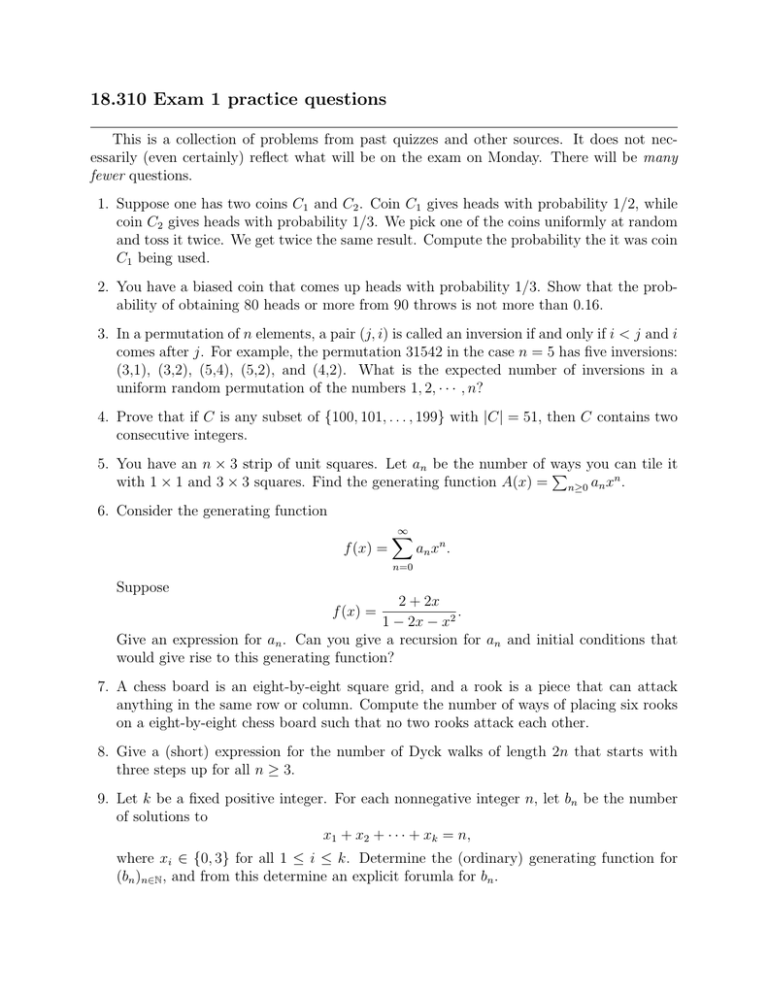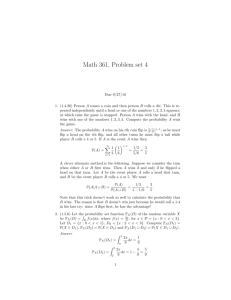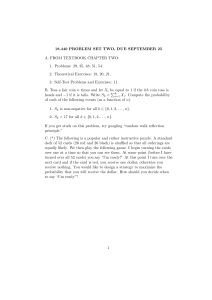18.310 Exam 1 practice questions
advertisement

18.310 Exam 1 practice questions
This is a collection of problems from past quizzes and other sources. It does not necessarily (even certainly) reflect what will be on the exam on Monday. There will be many
fewer questions.
1. Suppose one has two coins C1 and C2 . Coin C1 gives heads with probability 1/2, while
coin C2 gives heads with probability 1/3. We pick one of the coins uniformly at random
and toss it twice. We get twice the same result. Compute the probability the it was coin
C1 being used.
2. You have a biased coin that comes up heads with probability 1/3. Show that the probability of obtaining 80 heads or more from 90 throws is not more than 0.16.
3. In a permutation of n elements, a pair (j, i) is called an inversion if and only if i < j and i
comes after j. For example, the permutation 31542 in the case n = 5 has five inversions:
(3,1), (3,2), (5,4), (5,2), and (4,2). What is the expected number of inversions in a
uniform random permutation of the numbers 1, 2, · · · , n?
4. Prove that if C is any subset of {100, 101, . . . , 199} with |C| = 51, then C contains two
consecutive integers.
5. You have an n × 3 strip of unit squares. Let an be the number of ways
P you ncan tile it
with 1 × 1 and 3 × 3 squares. Find the generating function A(x) = n≥0 an x .
6. Consider the generating function
f (x) =
∞
X
an x n .
n=0
Suppose
2 + 2x
.
1 − 2x − x2
Give an expression for an . Can you give a recursion for an and initial conditions that
would give rise to this generating function?
f (x) =
7. A chess board is an eight-by-eight square grid, and a rook is a piece that can attack
anything in the same row or column. Compute the number of ways of placing six rooks
on a eight-by-eight chess board such that no two rooks attack each other.
8. Give a (short) expression for the number of Dyck walks of length 2n that starts with
three steps up for all n ≥ 3.
9. Let k be a fixed positive integer. For each nonnegative integer n, let bn be the number
of solutions to
x1 + x2 + · · · + xk = n,
where xi ∈ {0, 3} for all 1 ≤ i ≤ k. Determine the (ordinary) generating function for
(bn )n∈N , and from this determine an explicit forumla for bn .
10. Consider the following game that Harry and Tom play. They toss coins until they see
three consecutive tosses that are either HHT or HTT, in that order. If they see HHT,
Harry wins. If they see HTT, Tom wins. For example, if they toss TTHTHTT, Tom
wins.
(a) Conditioned on the first flip being H, what is the probability that Harry wins before
they see two consecutive flips that are TH, in that order? Conditioned on the first
flip being H, what is the probability that Tom wins before they see two consecutive
flips that are TH, in that order? Note that if Harry wins first, Tom can’t win, and
vice versa.
(b) Assume they play until one of them wins. What is the probability that Tom wins
the game?
11. The projective plane of order 11 is a mathematical structure with 133 lines and 133
points. Any two lines intersect in one point, and any two points determine one line.
There are exactly 12 points on each line, and each point lies on exactly 12 lines.
Show that there is a coloring of the points of this projective plane with the colors red
and blue such that every line has at least two points of each color.
12. Suppose you have a bag with the same number of red, green, orange and blue balls.
Suppose you repeatedly draw a ball at random from the bag, observe its color, and
place it back in the bag. Let Y be the number of red balls you get out of n = 400
drawings. It may be convenient to let Xi be 1 if the ith ball is red, and 0 otherwise (for
i ∈ {1, · · · , n}).
(a) What are E[Y ] and Var(Y )?
(b) Derive an upper bound on P[Y ≥ 200] using (i) Markov’s inequality, (ii) Chebyshev’s inequality, (iii) the Chernoff bound.
Page 2






